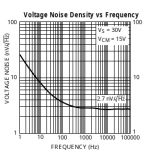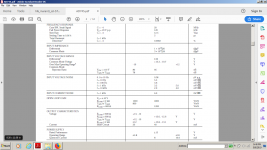Incredible! This OP amp is now available for $1.60 at Mouser. The price has been reduced by 50%.
lm4562 Texas Instruments | Mouser
lm4562 Texas Instruments | Mouser
Last edited:
Thanks. The newer TI opamps OPA16xx are surprisingly cheap, so maybe they have reduced the price of this one to stay competitive? Unlike the newer ones the LM4562 is available in DIP, so I think I'll slip a few into my next Mouser-order 🙂
Dumping the noisy chips? LM4562 / LME49720 low frequency noise - Audio forum - Audio - TI E2E Community
Or just a reflection of higher volume sales?
Or just a reflection of higher volume sales?
They make gorgeous op-amps for unity gain line level, honestly and i wouldn't probably use them for anything else, i wouldn't think of a different op-amp for that purpose either.
I think, they are dumping, now that too many people are aware of it.Dumping the noisy chips? LM4562 / LME49720 low frequency noise - Audio forum - Audio - TI E2E Community
Or just a reflection of higher volume sales?
Don't panic - test it!
Here a test procedure from TI: https://e2e.ti.com/cfs-file/__key/t...nts/00-14-01-00-00-80-75-78/Popcorn-Noise.pdf
I don't believe they sell out of spec opamps after this well known article.
If you use low input impedance circuits as D.self recommends in his books you will have less problems using opamps based on the described production process.
BTW: The NE5534/NE5532 was an expensive opamp in the first years!
BR, Toni
Here a test procedure from TI: https://e2e.ti.com/cfs-file/__key/t...nts/00-14-01-00-00-80-75-78/Popcorn-Noise.pdf
I don't believe they sell out of spec opamps after this well known article.
If you use low input impedance circuits as D.self recommends in his books you will have less problems using opamps based on the described production process.
BTW: The NE5534/NE5532 was an expensive opamp in the first years!
BR, Toni
They do, and their answer is, their production line testing doesn't screen well enough these out of specs...because it would take a too long time.I don't believe they sell out of spec opamps after this well known article.
Here is their excuse and they say, the customers should do the testing. 🙄
You do not see any of this in the data sheet. 😀
Have a look into the datasheet - there is information about noise density in datasheet. And popcorn noise can affect ALL opamps which are made with the same process - not only TI ones. The described ultra top performance of measured LM4562 opamps which was the need of one customer is only achieveable if he selects the best out of a big batch. IMHO the so called bad ones are mostly or all still in spec. Every transistor has a hFe min/max and noise min/max and you always need to select your pairs yourself. If this panic leads to the low price - no problem - I buy more and pre-select it for the application I want to build.
BTW: the above link to the so called bad opamps hasn't described the test method? Or I'm unable to see it...
BR, Toni
BTW: the above link to the so called bad opamps hasn't described the test method? Or I'm unable to see it...
BR, Toni
Attachments
The measured noise was way more than specified on the data sheet for many of the tested op amps.
And is related to one of a specific process at TI
And is related to one of a specific process at TI
Last edited:
As said before: there is no information how these tests have been taken nor is the wafer process TI specific.
BR, Toni
BR, Toni
Have a look into the datasheet - there is information about noise density in datasheet. And popcorn noise can affect ALL opamps which are made with the same process - not only TI ones. The described ultra top performance of measured LM4562 opamps which was the need of one customer is only achieveable if he selects the best out of a big batch. IMHO the so called bad ones are mostly or all still in spec. Every transistor has a hFe min/max and noise min/max and you always need to select your pairs yourself. If this panic leads to the low price - no problem - I buy more and pre-select it for the application I want to build.
BTW: the above link to the so called bad opamps hasn't described the test method? Or I'm unable to see it...
BR, Toni
It seemed to me that the noise measurements weren't very far from the datasheet which is a big vague under 100hz, plus nobody knows
WHAT WAS THE SIGNAL SOURCE IMPEDANCE !!!
There's one more thing...his graphs are too linear in the 0-300hz region measured, even more linear than the datasheet graph which is a bit weird...
The guy is very picky...anyway, as i consider them perfect for unity gain line level.Now it became a true bargain and TI behave as professionals selling them right away but it might lead to a very different outcome, one that nobody really wants.They might cease 4562 production and launch a new model with odentical but verified specs at 3x the original price...
Last edited:
I was interested in LM4562 2.7nV/rt Hz until I got aware, many are out of specs, unusable for low noise applications.
May be a good bargain for other applications.
Do not think, noise measurements at these low level is easy.
No doubt a guaranteed 2.7nV/rt Hz op-amp is worth 3 times their dumping price.
May be a good bargain for other applications.
Do not think, noise measurements at these low level is easy.
No doubt a guaranteed 2.7nV/rt Hz op-amp is worth 3 times their dumping price.
When you need absolutely lowest noise then NE5532/34 is your component. Disadvantage is higher THD+N.
You can use your opamp to run high gain of >=100 to increase the noise output. Use an output filter to measure only the low frequency range e.g. < 1kHz or < 100Hz. Use battery powered little metallic case, put your opamp test circuit in there and use your scope to measure....
Do not think, noise measurements at these low level is easy.
...
For DIY an absolute value is not needed as long as you have some sample opamp to compare. Buy some different "ultra low noise" opamps to compare ...
The above link from post #11 - popcorn noise measurement pdf will help you.
BR, Toni
Last edited:
....................When you need absolutely lowest noise then NE5532/34 is your component. Disadvantage is higher THD+N.
Attachments
- Status
- Not open for further replies.
- Home
- Design & Build
- Parts
- LM4562 for $1.60

